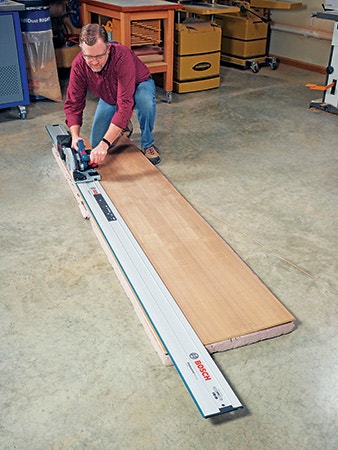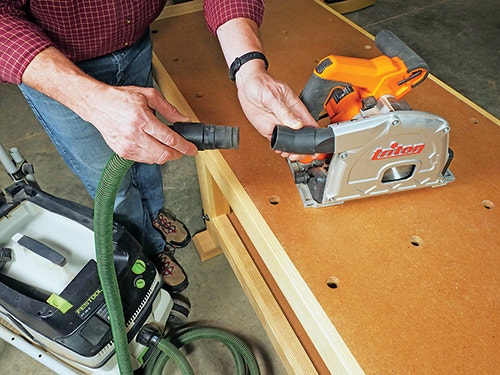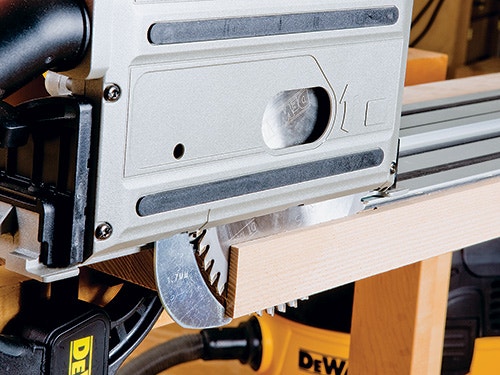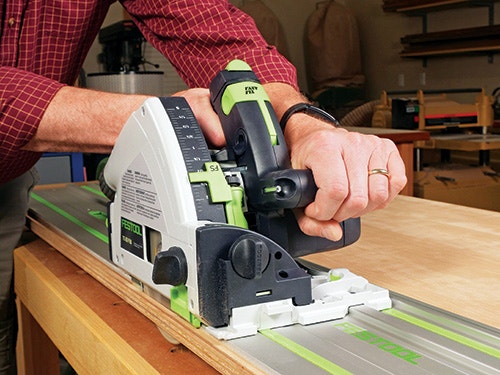Track Saws and Circular Saw Fundamentals
There are a number of aftermarket products and a shopbuilt jig that can give your circular saw a performance boost without breaking the bank. Here are some options.
When many of us begin our do-it-yourself or woodworking endeavors as newbies, one of the first tools we often buy is an ordinary 6-1/2" circular saw. It's far cheaper than a decent table saw and makes quick work of cutting lumber or sheet goods.

That's why an economical circular saw seems like a great value. And it is! But it doesn't take many "freehand" cuts attempting to follow a layout line to realize that a circular saw takes some skill to wield accurately. And sometimes it makes rough, splintery cuts. The easiest way to improve the first problem is to either slide its base along a clamped straightedge or connect the tool to an auxiliary base that fits over a guide rail to keep cuts headed straight, without "steering" them along.
That "guided" convenience is the genius that prompted Festool to develop the first track saw many decades ago, with other tool labels following suit over the last 20 years or so. When I first tested track saws for Woodworker's Journal in 2009, there were only three manufacturers selling them. Now you can also find track saw models on the web pages of Bosch, DeWALT, Kreg, Mafell, Makita, RYOBI, Triton, WEN and, most recently, Milwaukee
How They're Different

Track saws may look similar to a circular saw you can buy for a fraction of the price, but that's where the common ground ends. Their blades retract into a shrouded guard until you thumb a release lever and pivot the motor assembly down to begin cutting. It enables these saws to either plunge into a surface — a great thing for flooring contractors or remodelers — or be fed into the edge of workpieces conventionally, like a circular saw.
But for us woodworkers, there are other advantages. A track saw's base fits over the channel of an aluminum guide rail and follows it for making laser-straight cuts. The edge or edges of the rail also have a pliable sacrificial strip that supports the workpiece where the blade teeth exit on the top side. It reduces the incidence of lifted fibers or chipping where an ordinary circular saw could leave a ragged mess. This strip also serves as a convenient way to align the guide rail with layout marks on a workpiece; the edge of the strip indicates the exact location of the blade's inner face.

Most of the motors on these saws have more sophisticated features than circular saw motors do, including soft start, EVS and electronic feedback circuitry that keeps the blade spinning at a constant speed, regardless of cutting load. Their upper blade guards and dust collection ports are carefully designed to whisk debris away much better than a circular saw can.

And many have a safety feature you won't find on any ordinary circular saw: a riving knife. That "shark fin" shaped appendage is located behind the track saw's blade, just like the riving knife on table saws made within about the last 12 years. On a track saw, the riving knife projects below the saw's base when the plunge mechanism is engaged, and it serves to keep the kerf of the cut open behind the blade. This way, should the workpiece's kerf close up during cutting, due to stresses in the material, it can't pinch the blade and lead to a dangerous kickback. Some models even have a kickback stop incorporated into the saw's subbase design, or an anti-kickback stop can be fitted to the guide rail separately.
Keep the inspiration coming!
Subscribe to our newsletter for more woodworking tips and tricks





